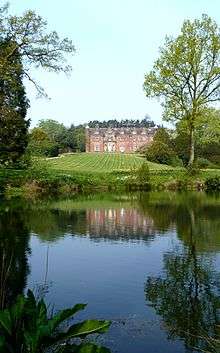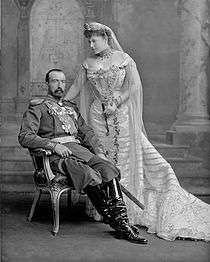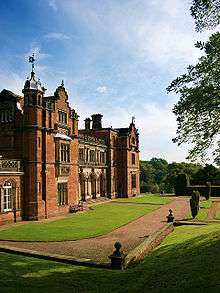Keele Hall
Keele Hall is a 19th-century mansion house at Keele, Staffordshire, England, now standing on the campus of Keele University and serving as the university conference centre. It is a Grade II* listed building.[1]

History
The manor of Keele was held by the Sneyd (pronounced Sneed) family and in about 1580 Ralph Sneyd built a large gabled Tudor style house there. The family prospered as coal (in nearby Silverdale, Staffordshire) and iron owners and also brick and tile manufacturers. In about 1851 the old house was replaced with the current imposing mock Jacobean design by architect Anthony Salvin. The three storeyed castellated entrance front has four octagonal turrets and other fronts have curved gables.
The 19th century stable block known as the 'Clock House' also has Grade II listed building status. During the English Civil War (1642-1651), Keele Hall was briefly instrumental is providing an asylum for King Charles II after the unfortunate Battle of Worcester in 1651.[2] In the mid to late 19th century, Edward VII visited Keele Hall, both as Prince of Wales and later King.[3]
The park was landscaped circa 1768-70 by William Emes, who added to or enlarged existing ponds and planted trees to conceal what remained working farms in the park.[4] Its main natural feature is the wooded valley with ponds running south-east from Keele Hall to Springpool Wood at the park's southern extremity, abutting the M6 motorway. The pool in that wood was originally a hammer pond serving a forge.
Grand Duke Michael Mikhailovich of Russia

Keele Hall was rented by Grand Duke Michael Mikhailovich of Russia, a son of Grand Duke Michael Nicolaievich of Russia and a grandson of Tsar Nicholas I of Russia, and his wife Countess Sophie von Merenberg, between 1900 and 1909. They had undertaken a morganatic marriage that meant they would spend the rest of their lives living in exile in England, France and Germany. During the ten years the Grand Duke lived at Keele Hall, he took up the life of an English country gentleman. The town council of Newcastle-under-Lyme even conferred on him the distinction of Lord High Steward of the borough.
1945-Present
The Hall was requisitioned by the army during World War II and in 1948 with the aid of grant funding the Keele estate was purchased from another Ralph Sneyd for the establishment of the University College of North Staffordshire, which in 1962 became Keele University.
References
- English Heritage website - Keele Hall
- Ward, John 'The Borough of Stoke-upon-Trent, in the Commencement of the Reign of the Reign of her Most Gracious Majesty, Queen Victoria', 1843, W Lewis & Son, London
- Kolber, Johhn Murray;'The Sneyd: Squires of Keele', University of Keele, 1976
- http://www.parksandgardens.org/places-and-people/site/1882?preview=1
Literature
| Wikimedia Commons has media related to Keele Hall. |
- J. M. Kolbert: The Sneads & Keele Hall, University of Keele, 1967.
